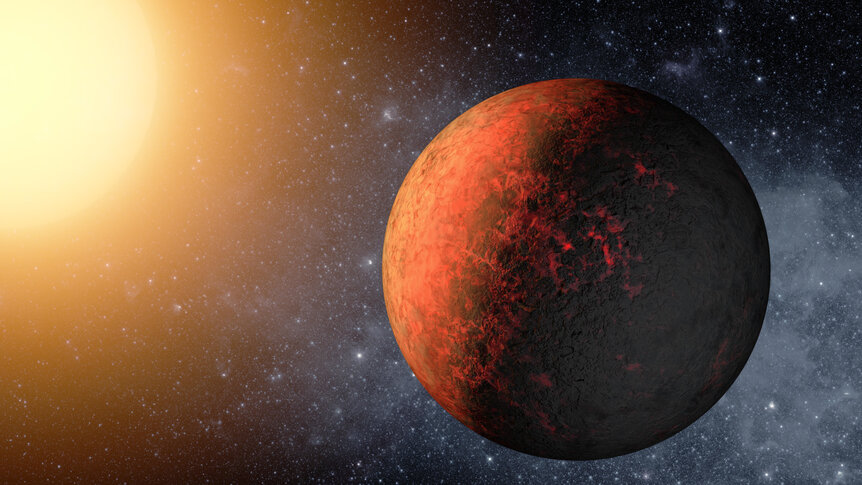Create a free profile to get unlimited access to exclusive videos, sweepstakes, and more!
Scorching Super-Earth discovered spinning beside a slowly dying star

Amid the tapestry of exotic exoplanets, protoplanets, astral bodies, and moons scattered about the infinite reaches of the universe, the class of rare worlds scientists find most intriguing are the bloated bodies known as super-Earths, named for their enlarged size relative to our own home planet.
Simmering just outside our solar system, a hot new super-Earth has been discovered lurking in the HD 164922 planetary system roughly 72 light years off in the constellation of Hercules. This simmering exoplanet orbits a brilliant G9-type star known as Gliese 9613, a stellar body just smaller than the Sun and calculated out to be an ancient 9.6 billion years old.
In a new research paper led by Dr. Serena Benatti from the INAF – Astronomical Observatory of Palermo and published in Cornell University's online journal Astronomy & Astrophysics, this roasting new planet catalogued as HD 164922d is actually one of three behemoths in the nearby planetary system.
The first found body is the Saturn-mass planet HD 164922b, initially discovered in 2006, is 0.3 times the mass of Jupiter and locked in an expansive orbit every 1,201 days from much further away at 2.2 AU (astronomical units).
The second of the exotic trio, a hot-tempered super-Earth 12.9 times larger than our home planet, was claimed in 2016 while updating the orbit of planet b. It's a temperate sub-Neptune exoplanet called HD 164922c that orbits its host star once every 75.8 days from a distance of 0.35 AU.
"We discovered this new super-Earth within the framework of an Italian observing program called GAPS (Global Architecture of Planetary Systems)," Benatti tells SYFY WIRE. "We are carrying on this project since 2012 with the 3.6m Telescopio Nazionale Galileo at the Roque de Los Muchachos Observatory in La Palma. Exoplanetary systems show a large variety of architectures, but only recently a number of systems hosting both giant and low-mass planets (like, for example, our Solar System) have been detected.
"HD 164922 was previously known to host a Saturn-mass planet orbiting with a period of about three years and a Neptune-mass planet in a closer orbit. We observed this target with the HARPS-N spectrograph that allows for high precision radial velocities (this is our exoplanets detection method, that measures the stellar 'wobble' due to the interaction with the planetary companion)."
Benatti and her team were hunting for low-mass candidates in the depths of the HD 164922 system, utilizing data captured by the sensitive HARPS-N (High Accuracy Radial velocity Planet Searcher for the Northern hemisphere) spectrograph at the Roque de los Muchachos Observatory in Spain's Canary Islands, when they uncovered another surprise member of the solar system.
Due to the high sensitivity of the HARPS-N data collated, researchers were surprised to spot the third smaller exoplanet they named HD 164922d, a hyper-hot planet orbiting Gliese 9613 at an extremely close-in distance of only 0.1 AU.
"Our observations showed that there was one additional hidden signal below the signature of the two known planets and the one generated by the stellar activity (like starspots)," she adds. "Indeed, this signal is related to a new 'lighter' companion, orbiting the star every 12.5 days. The HD164922 system is not a Solar System analog, but it confirms that gaseous giant planets do not compromise the formation and the evolution of low-mass planet companions."
Since the first true exoplanet, named 51 Pegasi b, was spotted orbiting a main sequence sun-like star back in 1995, astronomers and scientists have located hundreds of Earth-sized planets spinning outside our solar system, greatly increasing the chances of finding life existing elsewhere.
When you add in all discovered exoplanets of various sizes, mainly revealed from the Hubble Space Telescope and Kepler the total rises to more than 4,100 reported worlds, with thousands more still unidentified and uncatalogued.
From the seven Earth-sized planets of the Trappist-1 system, to the lone rocky world of Kepler-442b transiting its K-type star in the constellation Lyra, astronomers and astrophysicists hope to someday mount exploratory missions to their exotic destinations to further investigate these worlds as we continually push the bounds of discovery past our little corner of the Milky Way.




























